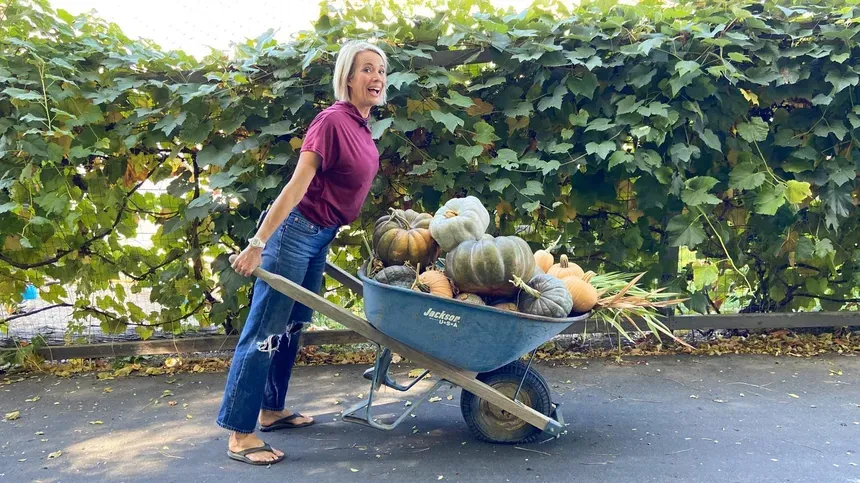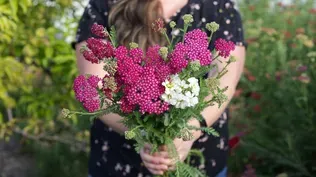Modern Gardener
How To Make Atchara
Episode 120 | 8m 7sVideo has Closed Captions
Hassle-free Atchara Quick Pickle
Looking for an easy atchara quick pickle? We teamed up with Chef Johndel Yarisantos and Wasatch Community Gardens to bring you this hassle-free recipe. Plus, learn how to grow everything you'll need for it in your own garden. You’ll fall in love with this traditional Filipino side dish that pairs nicely with almost any meat, tofu, rice – and yes, even pizza, we tried it.
Problems with Closed Captions? Closed Captioning Feedback
Problems with Closed Captions? Closed Captioning Feedback
Modern Gardener is a local public television program presented by PBS Utah
Modern Gardener
How To Make Atchara
Episode 120 | 8m 7sVideo has Closed Captions
Looking for an easy atchara quick pickle? We teamed up with Chef Johndel Yarisantos and Wasatch Community Gardens to bring you this hassle-free recipe. Plus, learn how to grow everything you'll need for it in your own garden. You’ll fall in love with this traditional Filipino side dish that pairs nicely with almost any meat, tofu, rice – and yes, even pizza, we tried it.
Problems with Closed Captions? Closed Captioning Feedback
How to Watch Modern Gardener
Modern Gardener is available to stream on pbs.org and the free PBS App, available on iPhone, Apple TV, Android TV, Android smartphones, Amazon Fire TV, Amazon Fire Tablet, Roku, Samsung Smart TV, and Vizio.

Modern Gardener
Subscribe to the Modern Gardener YouTube channel for more videos and information on gardening, and share your gardening tips and stories in the comments section. Can't wait to GROW with you!Providing Support for PBS.org
Learn Moreabout PBS online sponsorshipPart of These Collections

Garden and Gardening Organization Features
See beautiful gardens and learn about local gardening organizations!
View CollectionProviding Support for PBS.org
Learn Moreabout PBS online sponsorship- Hey, it's Cynthia here with "Modern Gardener," and we have partnered with Wasatch Community Gardens and Chef John to make atchara.
Okay, so tell me, what is atchara?
- So atchara is a pickled green papaya.
- Oo.
- And you'll find that as accoutrements or side dishes in the Philippines.
All over.
- Awesome.
Tell me what it tastes like.
- Well, it has quite the crunch and it's pretty sweet and sour, just like you would with any pickle.
- What about the aromatics?
What does it smell like?
- So that's what makes it really special is that we actually add ginger, Thai chilies, cloves of garlic, and it actually mellows it down and puts it all together.
And it comes with this really savory type of a pickle.
- Okay.
But tell me how you would use it.
What would you put this on?
- [John] Oh, it is perfect on fish or grilled chicken, pretty much anything meat like.
I swear you could probably even put this on pizza.
- Okay, so not on ice cream?
- Not on ice cream.
I mean- - 'Cause pickles and ice cream are a thing, you know.
- It can, it can, they can.
It could probably be a sorbet.
- A sorbet, perfect.
Okay, now I heard that this is like an heirloom recipe, some kind of tradition, right?
- And you heard right.
Yep, definitely.
- So where did this recipe come from?
- This recipe came from my grandmother.
It's her own personal recipe.
I asked her if I could share it and she just wants people to have good atchara at home, so.
- Oh, that's so nice.
- Yeah.
- That's awesome.
Well, I'm excited to try this.
Love to give a quick shout-out to our amazing sponsors, Red Butte Gardens and Merit Medical, for making videos like this possible.
(bright music) - What you're gonna need is eight ounces or one cup shredded green papaya, (jazzy music) one whole carrot julienned or shredded, and then 10 cloves of garlic thinly sliced, and then 1/4 yellow onion thinly sliced, and then a knob of ginger.
And then for the brine, what you'll need is two cups of distilled white vinegar and 1 1/3 cups of sugarcane sugar and two tablespoons of peppercorn, two teaspoons of salt, and then two bay leaves.
So traditionally when we use vinegar for atchara, we use sugar cane vinegar, but distilled, just as good.
You wanna make sure that before you're pickling or doing a quick pickle, that these are clean So these have been sanitized.
We're gonna go ahead and grab our papaya and we're gonna put it in the bowl without the salt.
And then you're gonna put the salt right over it.
The main idea of doing this is taking out the moisture and the bitterness, and then we're gonna mix it up.
We're gonna wait five to 10 minutes after it's done being mixed up.
So while we're waiting, we can lay out our cheesecloth on the second bowl.
We can go ahead with our mixing bowl, mix everything together.
You're gonna mix it until it looks really pretty (jazzy music continues) or just thoroughly mixed.
So when my grandma was making this, she wanted to put in aromatics that won't punch you in the face too hard.
And the secret ingredient is actually the ginger.
It brings it all together.
And once it starts to mellow out within the brine, it has a way better profile flavor than most of these other aromatics.
So I'm gonna go ahead and squeeze this.
And this is the most important ingredient because of texture.
You want that crunch.
It's just an unripe papaya.
That's why you can almost use any unripe fruit to pickle.
Alright, now that it's thoroughly mixed and pretty, we're gonna go ahead and pack it into our mason jar.
And then you wanna leave enough space for the brine, 1 1/2 inch.
This will last a long time because of the acidic content as well as the the sugar content.
- I have Celia here with Wasatch Community Gardens and she's gonna show us what you can grow in your garden to make this delicious treat.
So Celia, tell me what you guys have growing that we can use in our atchara.
- So we're using onion, garlic, hot peppers.
So Thai chilies, we typically don't grow them 'cause they take so long to turn red and everything.
And then we are also doing carrots.
- And I know that ginger's also a big aspect in this, but I think that's for a whole other episode of how to grow ginger in Utah.
- Yeah, I do have a garden nerd friend that has it growing in her greenhouse and stuff.
We do have some community gardeners that have grown it outdoors.
They typically stay small, but it can be a fun experiment.
- Tell me about growing carrots in Utah.
What have you learned?
When do you like to harvest 'em?
- So I mainly do a fall carrot planting, which can be tricky.
We plant in July, so we do have to do some tricks to make the carrots think that it's cold weather, but then we're harvesting in the cold and I feel like they taste so much better then.
Tell me about you and tricking carrots to think that it is fall weather in the middle of July.
- So the first 12 hours after you plant a carrot seed is the most crucial for temperature.
So you want to make sure your bed is nice and wet, cool, you've maybe shaded it to cool the soil temp down and then you put your seeds in.
And sometimes if you don't mind getting your seeds wet, you can put 'em in some cold water or actually throw 'em in the freezer too, to cool them down and then plant 'em.
Make sure that bed stays cool for the next seven to 14 days before they sprout.
- Okay.
Talk to me about onions.
What have you learned about growing onions?
- So onions, we just need to make sure that we're growing the right variety for our latitude and that we're putting 'em in early enough that they can get big before we get decreasing daylight hours.
That's what triggers the bulbing.
- Okay.
- For our storage onions.
- Now speaking of storage onions, tell me a little bit about curing onions in Utah because it's different.
- So sometimes there's books that tell you to cure your onions out in the sun.
That is not in Utah.
You're gonna cook your onions.
So putting them in a shady area that does get a nice breeze, so you're getting that neck to be able to dry down so it's not rotting in the center.
- Awesome.
All right, now garlic.
Garlic, man, I love garlic.
Takes forever to grow.
And then if you get two small bulbs, I mean it's a labor of love, let's put it that way.
But tell me about garlic and how you like to grow it.
- So we will be planting garlic in the garden the end of October here, and I'm gonna be teaching a class for that.
We put one individual clove in the ground about an inch to two inches down and pointy side up.
And that by the next July will make a whole head of garlic.
And we've got our soft neck garlics and our hard neck garlics.
- So tell me about curing garlic.
- It's similar to onions.
Do not cure it out in the sun here.
Put it in a shaded area where it has a good amount of air circulation and let those bulbs cure.
And after that I put them in the refrigerator so they'll take longer to sprout.
- Awesome.
Thank you so much, Celia, for letting us come and explore and learn all these amazing tips.
And we can't wait to see you until next time.
(jazzy music) (bright chiming)
Support for PBS provided by:
Modern Gardener is a local public television program presented by PBS Utah













